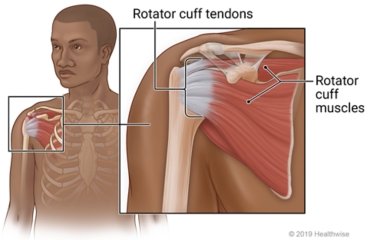Overview

The rotator cuff is a group of tendons and muscles around the shoulder that keeps the shoulder joint stable. It is what allows you to raise and rotate your arm. Over time, daily wear and exercise can cause the tendons to rub on the bones of your shoulder. This is called impingement. This condition may cause the tendons to bruise, degenerate, or tear.
In many people, these problems do not cause pain. When they do cause pain, you can do things to reduce the pain and swelling. These include rest, physical therapy, ice and heat, and anti-inflammatory medicine. If you still have pain after trying these treatments, you and your doctor can discuss having a steroid injection or surgery.
Follow-up care is a key part of your treatment and safety. Be sure to make and go to all appointments, and call your doctor if you are having problems. It's also a good idea to know your test results and keep a list of the medicines you take.
How can you care for yourself at home?
- Be safe with medicines. Read and follow all instructions on the label.
- If you are not taking a prescription pain medicine, ask your doctor if you can take an over-the-counter medicine.
- If the doctor gave you a prescription medicine for pain, take it as prescribed.
- Store your prescription pain medicines where no one else can get to them. When you are done using them, dispose of them quickly and safely. Your local pharmacy or hospital may have a drop-off site.
- Put ice or a cold pack on your shoulder for 10 to 20 minutes at a time. Try to do this every 1 to 2 hours for the next 3 days (when you are awake). Put a thin cloth between the ice and your skin.
- After 2 or 3 days, you can try applying heat to the area that hurts. Apply heat for 10 to 20 minutes at a time, several times a day. Put a thin cloth between the heat and your skin. You might also try switching between ice and heat.
- While holding a warm cloth on your shoulder, lean forward so your arm hangs freely, and gently swing your arm back and forth like a pendulum. You also can do this standing under a warm shower.
- Follow your doctor's advice for physical therapy. When your doctor says it is okay, try these stretching exercises. Do them slowly to avoid injury. Put a warm, wet towel on your shoulder before exercising. Stop any exercise that increases pain.
- Range-of-motion exercises. If it is not too painful, stretch your arm in four directions: across the body, up the back, to the side, and overhead.
- Pendulum exercise. This exercise does not use the arm muscles. Rather, it uses the legs and hips to create movement that makes the arm swing freely. To do the exercise, hold onto a table or the back of a chair with your good arm. Bend forward a little and let the arm with the sore shoulder hang straight down. Use the movement from your hips and legs to guide the slightly swinging arm forward and backward like a pendulum (or elephant trunk). Then guide it in circles that start small (about the size of a dinner plate). Do this exercise for at least 1 minute. Do it at least 3 times a day. As you have less pain, try bending over a little farther. This will increase the amount of movement at your shoulder.
- Wall climbing (to the side). Stand with your sore shoulder toward a wall, about an arm's length away. Then turn so your body is turned slightly toward the wall and your sore arm is slightly in front of you (about 30 degrees). Keeping your shoulder relaxed and down (not shrugged), walk the fingers of your sore arm up the wall as high as pain permits. Don't lean to the side. Hold that position for at least a few seconds. Slowly walk your fingers down to the starting position. Repeat 2 to 4 times, trying to reach higher each time.
- Wall climbing (to the front). Face a wall, standing so your fingers can just touch it. Keeping your shoulder relaxed and down (not shrugged), walk the fingers of your affected arm up the wall as high as pain permits. Keep your back straight. Don't lean back. Hold that position for at least a few seconds. Slowly walk your fingers down to the starting position. Repeat 2 to 4 times, trying to reach higher each time. As you can reach higher, you can take a step toward the wall as you walk your fingers up, then step back as you walk your fingers back down.
- Rest your shoulder when you are not doing stretches and other exercises. Your doctor may tell you to wait for the pain to go away before doing exercises. Do not lift heavy bags of groceries, play sports, or do anything else that makes you twist or stress your shoulder. Avoid activities where you move your affected arm above your head.
When should you call for help?
Contact your doctor now or seek immediate medical care if:
- You have severe pain.
- You cannot move your shoulder or arm.
- You have tingling or numbness in your arm or hand.
- Your arm or hand is cool or pale.
Watch closely for changes in your health, and be sure to contact your doctor if:
- Your pain gets worse.
- You have new or worse swelling in your arm or hand.
- You do not get better as expected.
Where can you learn more?
Go to http://www.healthwise.net/patientEd
Enter E207 in the search box to learn more about "Rotator Cuff Problems: Care Instructions".
Current as of: July 24, 2025
Author: Ignite Healthwise, LLC Staff
Clinical Review Board
All Ignite Healthwise, LLC education is reviewed by a team that includes physicians, nurses, advanced practitioners, registered dieticians, and other healthcare professionals.

